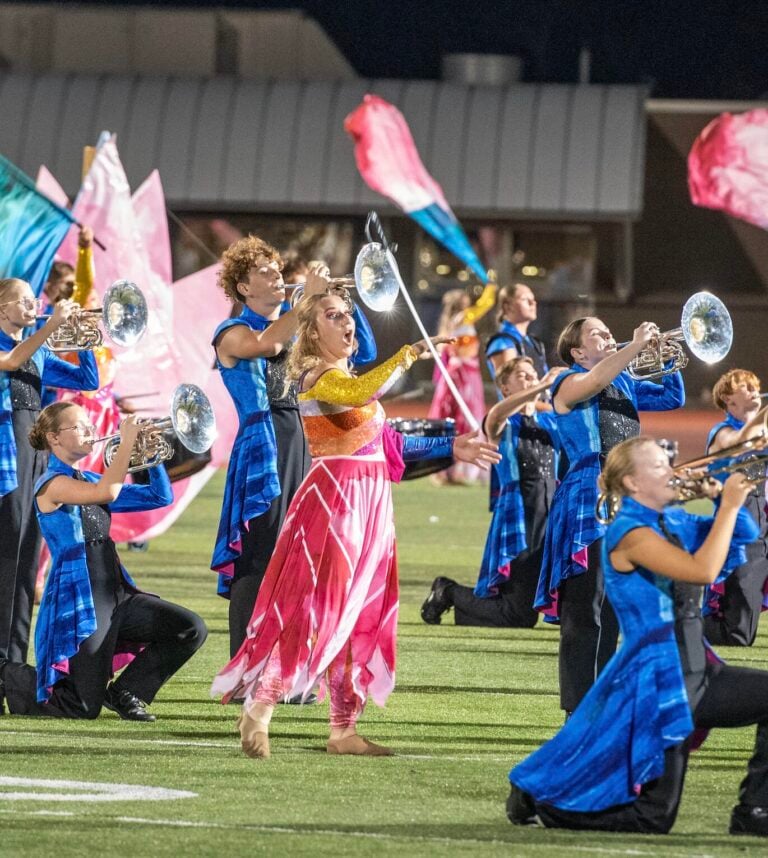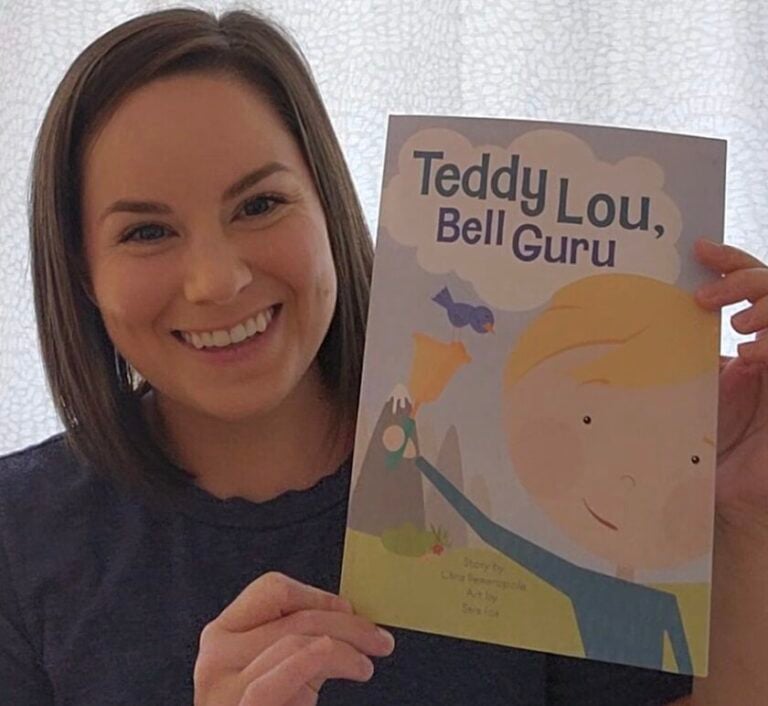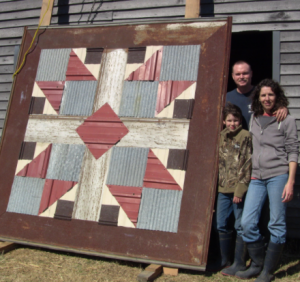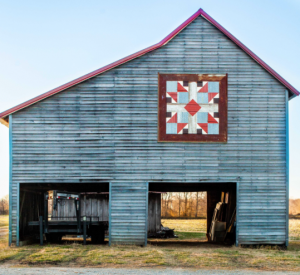There is a difference between cutting and ripping. A tornado shows you that difference. There are no calculations for the chaos. One roof can tear into a million pieces and land in as many places. Many of those pieces are scattered in the countryside that encompasses McKendree Church Road in Graves County. In fact, there are still tin remnants and debris piles from the tornado that passed through in 2016 on the afternoon of May 10.
It was sometime between the two tornadoes that Josh and Justine Riley talked about the idea of decorating the old tobacco barn with a barn quilt. Some ideas were passed around, maybe a pattern that was also a rooster or a piece of pottery, both of which hold significance for the couple. But nothing ever quite stuck and the barn remained empty
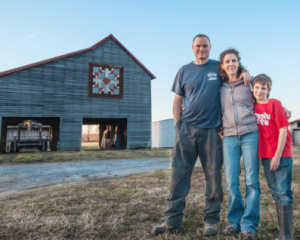
Nobody knows how old the family tobacco barn is. Robert Riley guesses it was built in the late 1800s or early 1900s, probably by his great-grandfather. The last time he recalls Burley tobacco being air-cured in it was in the 90s. In 1994 Robert replaced the barn’s old foundation with poured concrete. David Riley, his son, and Luke Thomas, his nephew were nine years old when they dug out the many sandstones that were the barn’s original foundation. By 2012 the barn was leaning and needing new siding. If babies could remember, James Riley’s first memories of the tobacco barn would be watching his father, Josh Riley, and grandfather, Robert Riley, climb scaffolding, drive nails and cut white and red oak boards while sweating in the heat of that summer’s drought.
One of Robert’s earliest memories of the tobacco barn happened in the late 50s. He had been working on the farm with his grandfather, James Floyd Smith, and cousin, Larry Lovett. A storm blew up and they ran to the tobacco barn for cover. Coot, as they called James, said he believed the storm would be a while and they might as well go to the house for an early lunch. When they returned to the barn after lunch they found some of the small pigs dead. The tobacco barn had been struck by lightning just where they’d been standing earlier, staying dry from the storm.
There was a small woodlot on the family farm from which timber was cut for building the barns, outbuildings and home. Before the 2021 tornado there were a dozen trees left standing and they could easily have been two hundred years old. With these giant trees gone, the tobacco barn is the oldest remnant of the family’s farming history down in the West Fork Clarks River bottoms.
Now after three tornadoes: 1956, 2016, and 2021 the tobacco barn looks great. The old rusted roof that was damaged and patched in the 2016 tornado is now completely replaced with a new red roof. Just the fact that the tobacco barn is still standing pushed Josh and Justine to make the quilt they’d talked about for years. The old damaged tin from the barns piled up and offered an opportunity. What about making the barn quilt out of tornado tin?
So, they started collecting tornado tin. With the red of the new roof as a starting point they collected some old red tin from a neighboring structure that was completely destroyed in the 2016 tornado. Piles and pieces of it still dotted the landscape. They got some tin from a neighbor, Teddy Youngblood, who lost his house to the 2021 tornado. Before the big black debris trucks came and took the rubble away, the Rileys found some bluish gray tin corrugated like cardboard. The tin was stamped with “Made in Japan” and had been part of Teddy’s outbuilding. They added it to their pile.
Justine chose a pattern from a wooden tray her mother had given her years before. It was made by an artisan using different wood grain inlaid to create a quilt pattern. She thought if the pattern could work for subtle wood grain it might be perfect for the color pallet of old rusty tornado tin. From that 11 inch tray, she scaled up to 8 feet and made a colored pencil pattern for them to follow. Josh welded together some 1/8 inch aluminum pieces to make an 8 foot by 8 foot backing for the barn quilt. They started quilting on February 12, 2022. All the procrastination of the past came together in 39 pieces. As Josh and Justine know well, creative projects start with a plan but things will change.
That is one of the many things they enjoy about the process.
During the quilting process Josh’s aunt, Teresa Thomas, pointed out that the quilt could use some more color. After lunch that day Josh, Justine and their son James visited a neighbor’s place that was hit by the tornado. Danny was up on the house roof patching. Danny and Debbie Jones’s workshop had entirely lost its green roof and the sides were leaning badly and torn. Danny graciously helped them gather some green tin, carefully traversing the yard and cow pasture, climbing over barbed wire where debris had laid it down. They also gathered some beige tin from the siding of the building. And as it turned out the brightness of the beige was just the contrast the quilt had needed.
The American quilt trail, starting just over 20 years ago, began with the desire to beautify an old tobacco barn in Adams County, Ohio. Donna Sue Groves influenced by her childhood love of barns, her mother’s quilting and a passion for bringing people together, presented the idea of a barn quilt trail and started a movement. Josh and Justine have been imagining what a tornado tin quilt trail marking the tornado’s route through Graves County or even Kentucky might look like. Their place was the last homestead hit in Graves County before the tornado moved into Marshall County. They have wondered, like many others, how do you carry and piece some of the past into the future?
On March 1, 2022 a small crew hung up the first tornado tin barn quilt in Graves County. With the use of pulleys, straps, ladders and a backhoe, Robert and Josh Riley slowly lifted the barn quilt up the side of the tobacco barn. Justine and Robert’s sister, Anita Thomas let them know when the quilt was high enough and in the right spot.
Meanwhile James Riley, with tripod and camera, was weaving in and out of the action. The quilt was bolted to the barn studs. Josh was up in the backhoe on the outside of the barn with 6-inch bolts and drill. Justine was on the inside of the barn up in the tier poles with washers and nuts to secure the bolts. The weather, the company and the new quilted addition to the barn made it a very memorable day.
The quilt is part of the barn, carrying pieces of its old roof and of another generation’s mark on it. Now when the Rileys look out the window, drive into their driveway or walk to the barn to feed the chickens, and see the barn quilt, it feels like it was always there, like it always belonged there.
Tin from five structures and two tornadoes along with many rivets, screws and measured cuts complete the barn quilt. Devastation is a great word to describe the aftermath of a tornado. The word comes from Latin meaning “entirely to make empty.”
A tornado is a master at destruction, ripping apart homes, buildings, barns, trees, stories and lives. A vast messy emptiness is left in its wake. And while it is natural to fill that void with sorrow and grief, it is important, no, it is essential to fill some of that space with beauty. It is essential to bring some of the ripped pieces together purely for the sake of decorating an old tobacco barn that survived three tornadoes and a lightning strike. Beauty is a beacon of hope; it is hope manifest. It is movement in a decided direction. It is cutting and piecing. It is creation, as an answer to destruction.












